MARIANI’S
Virtual
Gourmet
February
2, 2020
NEWSLETTER
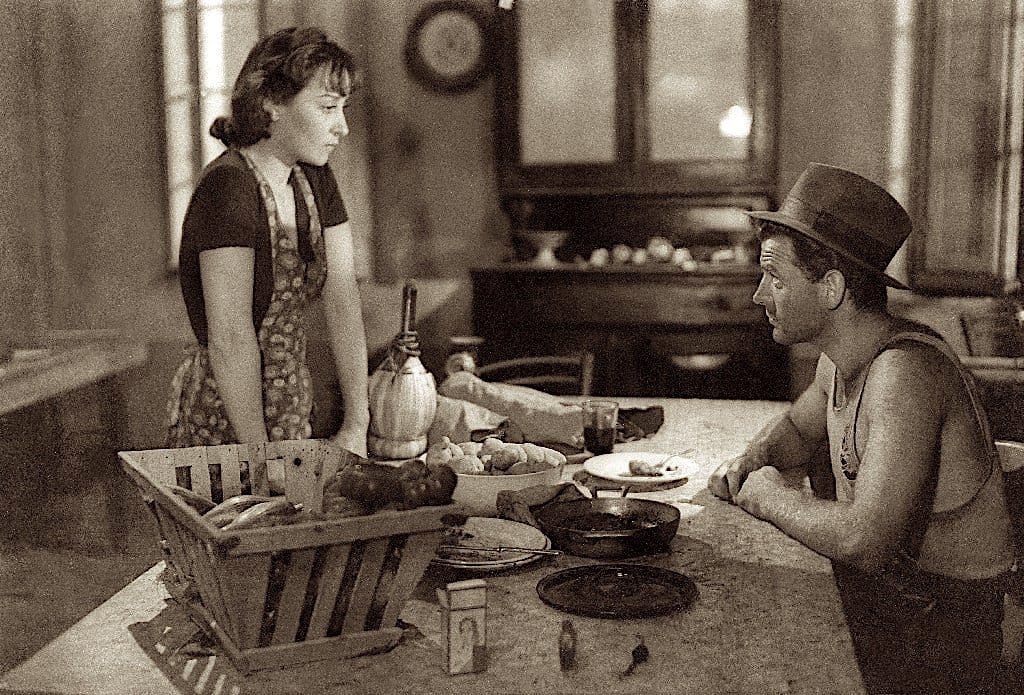
❖❖❖
IN THIS ISSUE
TUCSON, Part One
By John Mariani
NEW YORK CORNER
MADRE
By John Mariani
NOTES FROM THE WINE CELLAR
IS BURGUNDY GOING BACK TO THE FUTURE?
The Wines of Vincent Girardin
By John Mariani
❖❖❖
TUCSON,
Part One
By John Mariani

Photo by John Mariani 2019
If
Tucson had nothing more to offer than its
twilights and sunsets, it would be reason enough
to visit. In
fact, when you visit the city most
residents heartily recommend you get to the
outskirts if you seek the true
western spirit of the place, starting with
Sentinel Peak, a natural landmark
whose Mission Garden traces Tucson’s four
millennia history of agriculture.
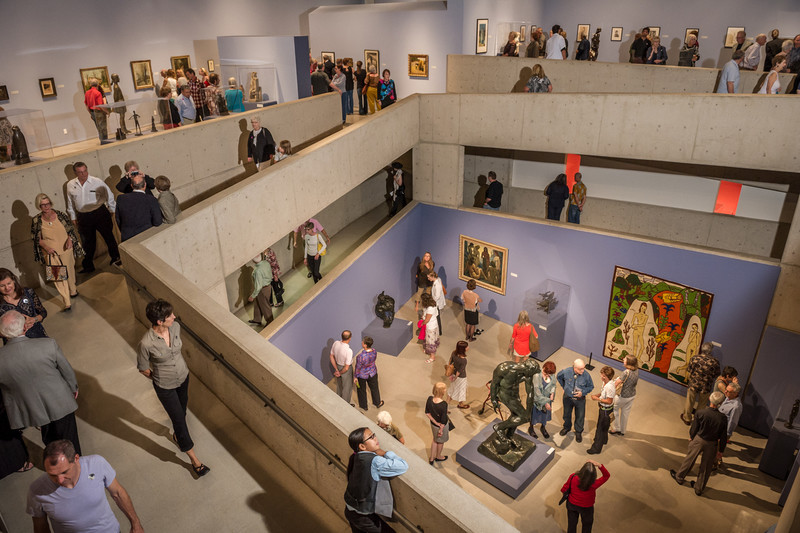 Alternately
there’s the Juan Baustista de Anza National Historic
Trail, which runs for
1,210 miles,
based on the route
the Spanish commander de Anza took 200 colonists
from Mexico all the way to San
Francisco Bay.
Alternately
there’s the Juan Baustista de Anza National Historic
Trail, which runs for
1,210 miles,
based on the route
the Spanish commander de Anza took 200 colonists
from Mexico all the way to San
Francisco Bay.
I didn’t have the time for any
such treks on my
last visit to Tucson, so I stayed close to
downtown, which has more than enough
historic and culinary attractions to occupy
several days in the area. The
four-mile Sun Link Tucson Streetcar connects
all six downtown districts,
making a casual off-and-on visit easy.
Tucson was established as a
Spanish military
fort in 1775, sadly appropriated from the Native
Americans who had lived there
for millennia. The current day Presidio San Agustín del Tucson
Museum has a reconstruction of the
original
Presidio, showing what life was like at a time the
American Revolution was in
full swing back east. From there you can walk a
2.5-mile loop trail through
downtown’s historic sites.
Here,
too, is the Old Town
Artisans street, established
in 1922, housing art galleries and shops built on
the vestiges of the original
Presidio wall. Right next door is the superb Tucson Museum of Art (above) and the Historic Block, founded in 1924.
The Museum was
relocated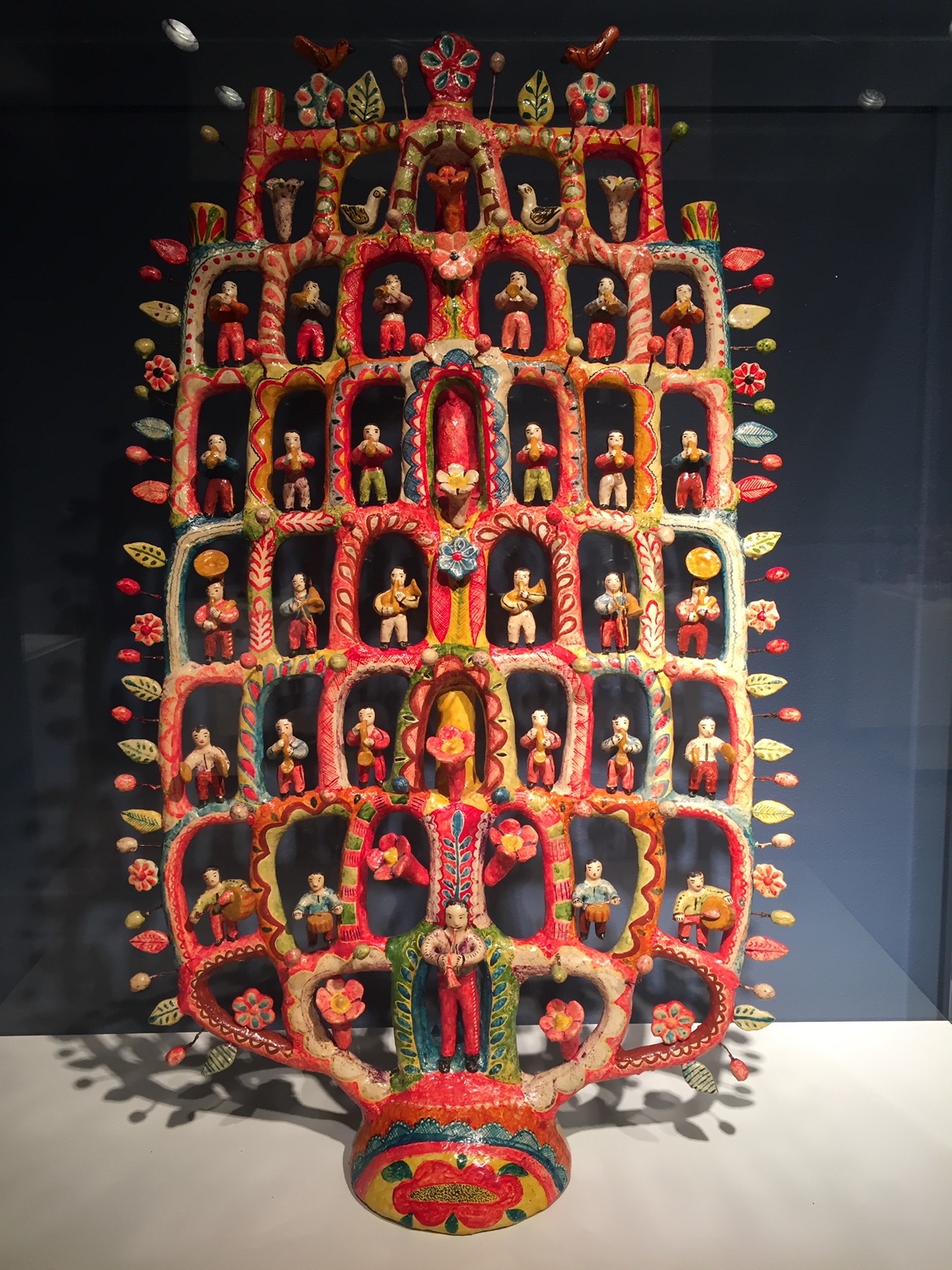 in 1975, now covering a four-acre
block of downtown. It’s one of the
finest collections of western art in the Americas,
with strong holdings in
modern and Asian art as well. The Museum has just
broken ground on the Kasser
Family Wing that will feature an extensive
collection of Pre-Columbian and
Latin American Art.
in 1975, now covering a four-acre
block of downtown. It’s one of the
finest collections of western art in the Americas,
with strong holdings in
modern and Asian art as well. The Museum has just
broken ground on the Kasser
Family Wing that will feature an extensive
collection of Pre-Columbian and
Latin American Art.
I was delighted by the
museum’s Mexican folk
art by the Puebla artist Francesco Flores’s “Brass
Band Tree of Life” (1996; right),
and currently there is an exhibition on “The
Western
Sublime: Majestic Landscapes of the American
West,” with a daunting array of
artists ranging from Ansel Adams and Albert
Beristadt to Eadweard
Muybridge and the Cherokee artist Kay
Walkingstick.
 Nine miles south of town
is a very fine Mission
Xaviar del Bac (left), the oldest
intact European structure in Arizona, one of the
largest and most beautiful of
those established by the Spanish in 1692, with the
current structure finished
in 1797. An earthquake damaged the mission in 1887
and a lightning strike hit
the West Tower lantern in 1939. Major restoration
work began in 1999 and continues,
and the Mission is now a National Historic
Landmark.
Nine miles south of town
is a very fine Mission
Xaviar del Bac (left), the oldest
intact European structure in Arizona, one of the
largest and most beautiful of
those established by the Spanish in 1692, with the
current structure finished
in 1797. An earthquake damaged the mission in 1887
and a lightning strike hit
the West Tower lantern in 1939. Major restoration
work began in 1999 and continues,
and the Mission is now a National Historic
Landmark.
While the main building is
constructed in the
usual mix or brick, stone and lime mortar, Mission
Xaviar’s masonry vaults are
unique among U.S. Spanish Colonial buildings. Of
particular interest are the statues,
whose artists are unknown, draped in stiffened
gessoed clothing (below). A shell motif
pays homage to the patron saint of Spain, James
the Greater. (There is a very
good 20-minute video that 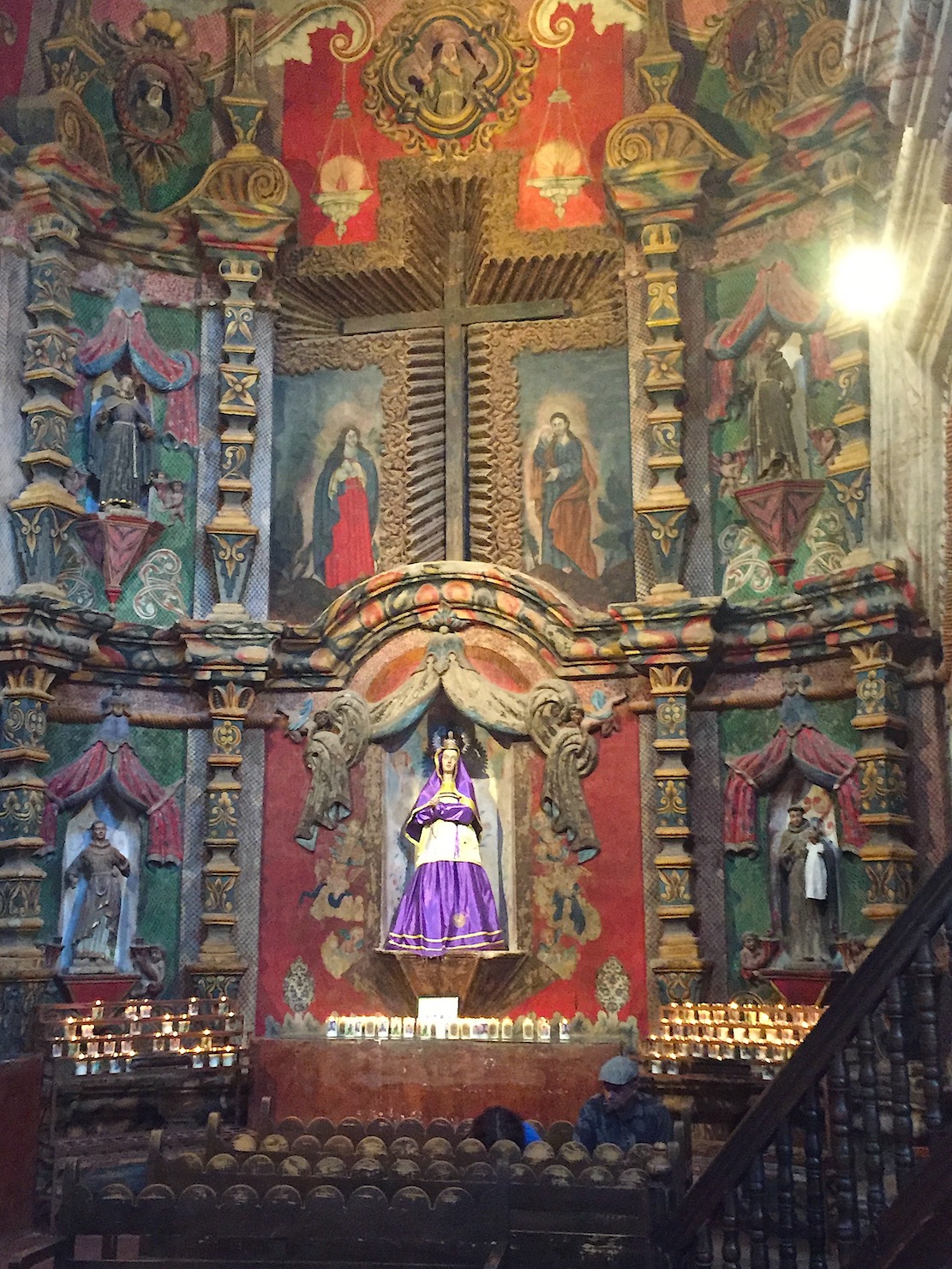 fills you
in on its past and present.)
fills you
in on its past and present.)
I’ve always had an avid
interest in aviation
history so it was requisite for me to visit the Pima Air & Space Museum (below),
spread over several acres of the Sonoran
desert outside of Tucson. To my mind, this is one
of the finest museums of its
kind with an astounding array of airplanes from
every era. The indoor setting
of seaplanes shows just how huge they were, and
the carrier-based Grumman F-14
and Vietnam War fighter planes possess impressive
power just sitting on the
ground. There are B-17 and B-29
bombers, Kamikaze fighters, uniforms, flight logs,
instruction manuals, flags, gun
sights, bombs and rockets. The Joyce M. Corrigan Women in
Flight
Gallery examines women’s contributions to the
history of aviation.
 All the planes in the
indoor galleries are in impeccable
shape, looking ready to be shipped to a theater of
operation, but outside an
even greater number are lined up on the tarmac in
the broiling Arizona sun,
which has not been kind to their metal skins or
colorful paint.
All the planes in the
indoor galleries are in impeccable
shape, looking ready to be shipped to a theater of
operation, but outside an
even greater number are lined up on the tarmac in
the broiling Arizona sun,
which has not been kind to their metal skins or
colorful paint.
I was determined to see everything outside, but because of their sheer number and the June heat bearing down on me with overwhelming intensity, I made a vow to return at a cooler time of year to try to take it all.
(Tucson’s restaurant
scene has gotten much better in the last five
years, and I shall be devoting
another article to that subject soon.)
By John Mariani
214 Franklin Street
Brooklyn, NY
718-389-8700
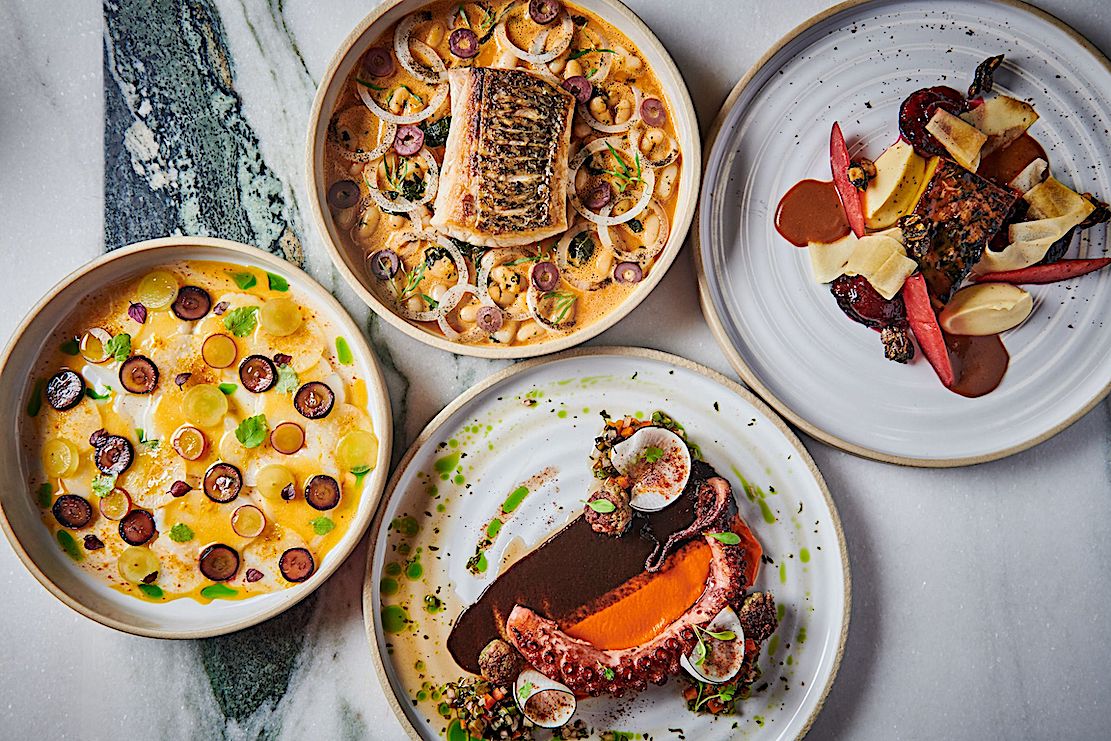
Greenpoint,
as
Millennial nesters happily boast, is the hottest
neighborhood in Brooklyn right
now, with 19 projects in development, the
40-story, block-long Greenpoint
tower, and plans to make 22 waterfront acres into
10 buildings with 5,500 units.
Such gentrification, as Spike Lee’s nostalgic
series She’s Gotta Have It bemoaned, has
radically changed the historic
paradigm of the area, not least in the opening of
new restaurants.
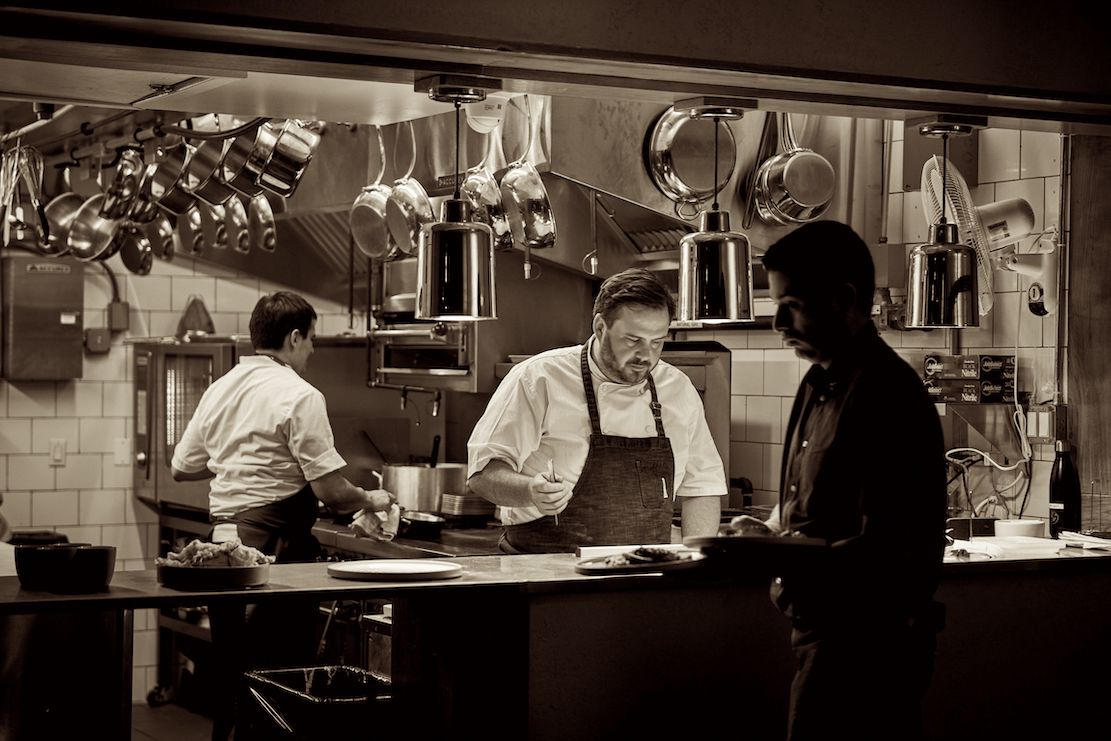 One of the
best that
is sure to benefit from all this activity is MADRE,
located within the Franklin
Guesthouse boutique hotel, whose owners also operate
the Henry Norman Hotel and the Box House Hotel
nearby. Open six months now,
MADRE is small, intimate and very friendly, with
just 45 seats and bar. Executive Chef Bryan Noury (left), whose
experience has an impressive international scope,
features an admirably tight
menu in which every dish has been thought through to
offer maximum flavor.
One of the
best that
is sure to benefit from all this activity is MADRE,
located within the Franklin
Guesthouse boutique hotel, whose owners also operate
the Henry Norman Hotel and the Box House Hotel
nearby. Open six months now,
MADRE is small, intimate and very friendly, with
just 45 seats and bar. Executive Chef Bryan Noury (left), whose
experience has an impressive international scope,
features an admirably tight
menu in which every dish has been thought through to
offer maximum flavor.
Even
when the dish sounds familiar, like “Castelvetrano
Olives” ($6) or “Heirloom
Beets” ($17) or even “Chicken” ($25), Noury uses all
his skills to make them
taste unlike any version you’ve had before. Those
olives are marinated in many
spices for many hours, emerging with more of a
piquant, lemon-accented burst of
flavor than saltiness. Those beets are treated in a
similar manner, served with
feta foam and a puffed wild rice crisp. Winter
squash ($19), which can easily
be a bland item, are cuddled with farro, persimmon
and miso caramel, and Noury
has a 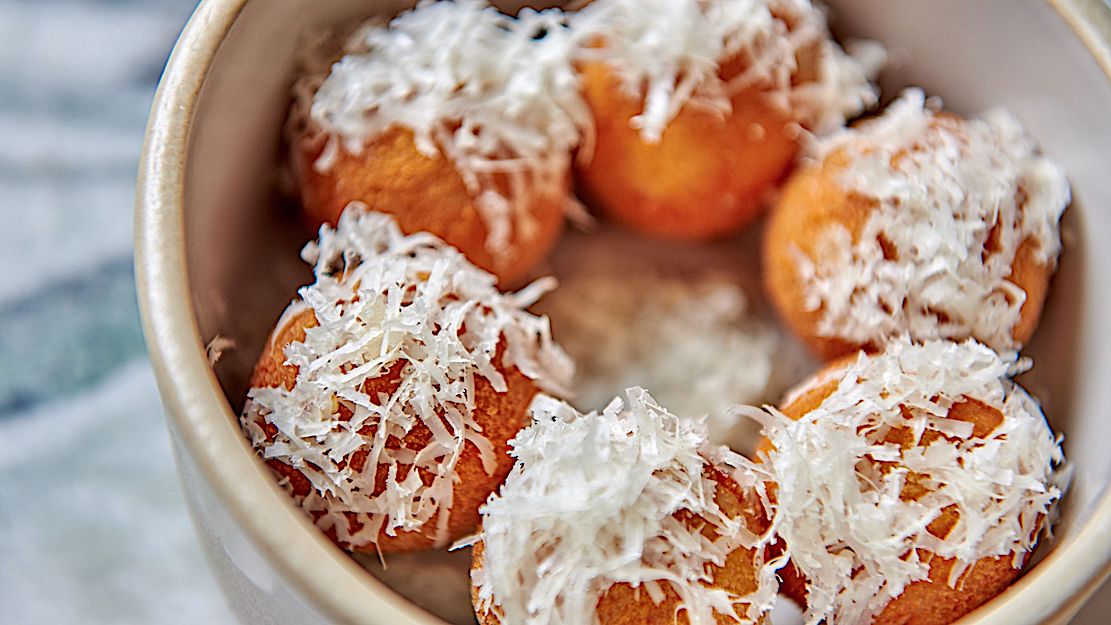 true appreciation of the
power of acid—and a splash of chilies— in
brightening his food.
true appreciation of the
power of acid—and a splash of chilies— in
brightening his food.
The dining room is L-shaped, with
a sofa area
down a couple of steps, and its casual vibe
complements the seriousness of the
cooking, all to the good. Unnecessary,
unidentifiable, throbbing music does not
add to the vibe but overpowers it. Manager Stephen
Dougherty, who also stocks
the well-conceived wine list that happily includes
some New York Finger
Lakes bottlings,
clearly manifests
his love for the job in his cheerful attitude.
There was an
amuse of rutabaga soup flavored
with sassafras. You receive small baguettes and
butter to begin, and I do
recommend those olives, as well as crispy croquetas (right) that
ooze Gruyère and black
truffle, with vinegar powder ($14). Oysters (six for
$16 twelve for $30) get
their acidic touch from a tangy pickled rhubarb
mignonette. A scallop crudo
($20) was outstanding, in an aji miso
with daikon and grapes for
balance.
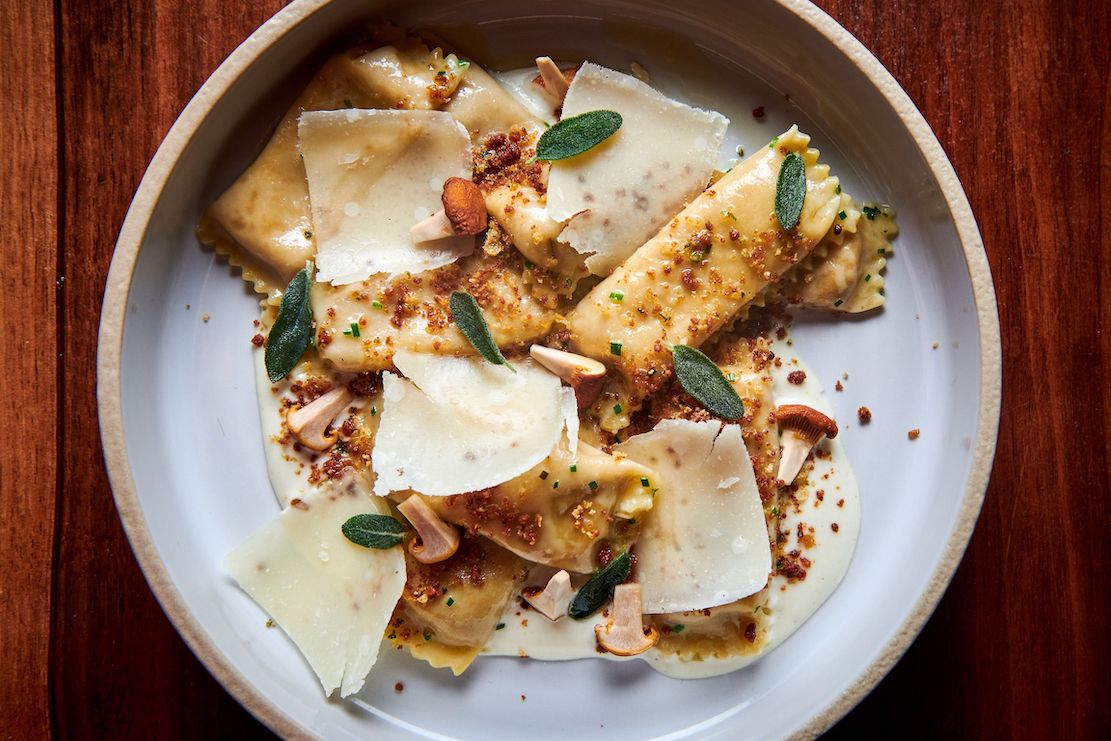 The ample
charcuterie board ($24) contains very
good, nicely fatted pâté de campagne and velvety
chicken liver mousse, along
with Lady Edison country ham, produced in North
Carolina from a cross breed
that includes Spain’s famous pata negra
pigs. It is not as salty as traditional country
hams, but I also found it
somewhat dry and lacking in the kind of glistening,
silky fat you find in
Spanish hams.
The ample
charcuterie board ($24) contains very
good, nicely fatted pâté de campagne and velvety
chicken liver mousse, along
with Lady Edison country ham, produced in North
Carolina from a cross breed
that includes Spain’s famous pata negra
pigs. It is not as salty as traditional country
hams, but I also found it
somewhat dry and lacking in the kind of glistening,
silky fat you find in
Spanish hams.
You’ll find octopus on nearly
every menu in New
York these days, but Noury gives it a novel twist
with chimole, green chorizo and pickled
cactus ($21). Few menus,
however, do “Honey Nut Agnolotti,” with chestnuts, a
rich fontina fondue and a
touch of sage ($19), a luscious dish but one whose
honey element sweetened it
too much (left).
The mundane-sounding “Chicken”
was outstanding,
perfectly crisp skin and juicy, flavorful meat, with
confit potatoes,
escarole—an underused, wonderful green—olives and
black garlic. Striped bass
also sounds 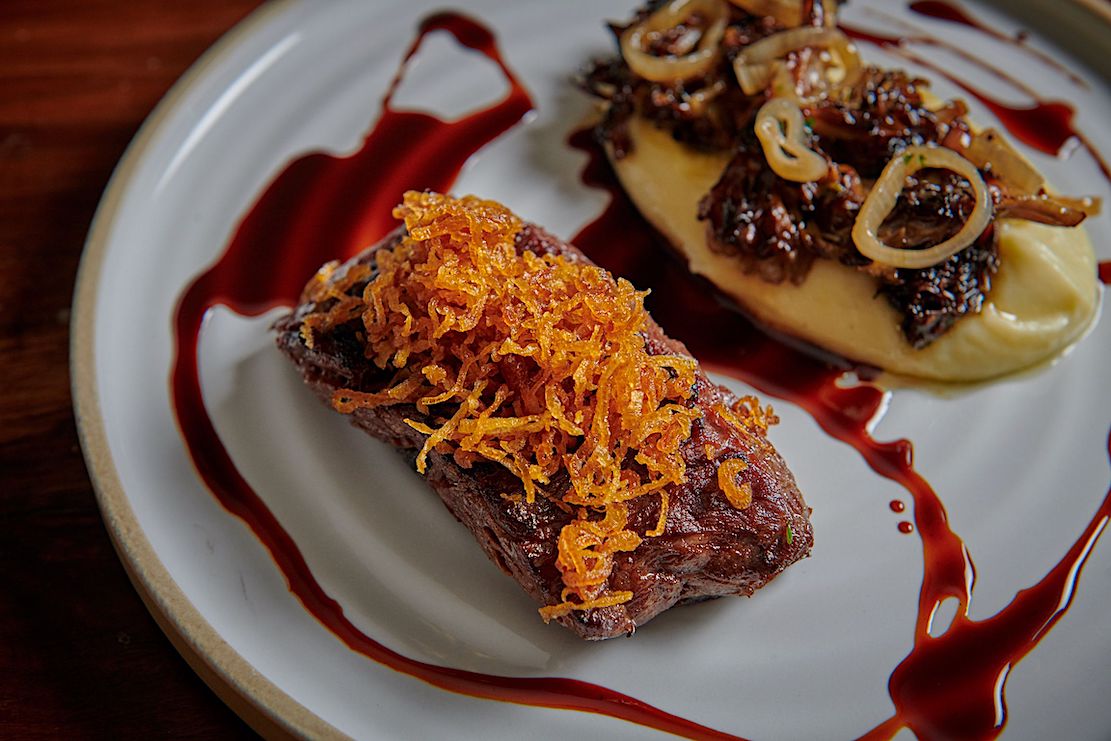 a bit ho-hum
these days, but Noury’s is superbly cooked to
exceptional succulence, served with tender
cannelloni beans, a minestrone of
vegetables laced with harissa and kalamata olives
($29).
a bit ho-hum
these days, but Noury’s is superbly cooked to
exceptional succulence, served with tender
cannelloni beans, a minestrone of
vegetables laced with harissa and kalamata olives
($29).
You gotta have
been on a menu anywhere, but here again
there’s a twist: Noury removes the cap, called the
deckle ($45), from 60-day
dry aged ribeye (right),
and by careful cooking that does not overcook the
meat, this
poor man’s cut tastes better than the beef it
covers. (I asked what he does
with that beef, and Noury says it’s used for
banquets.) The dish comes with maitake mushrooms
and a finely wrought
bordelaise.
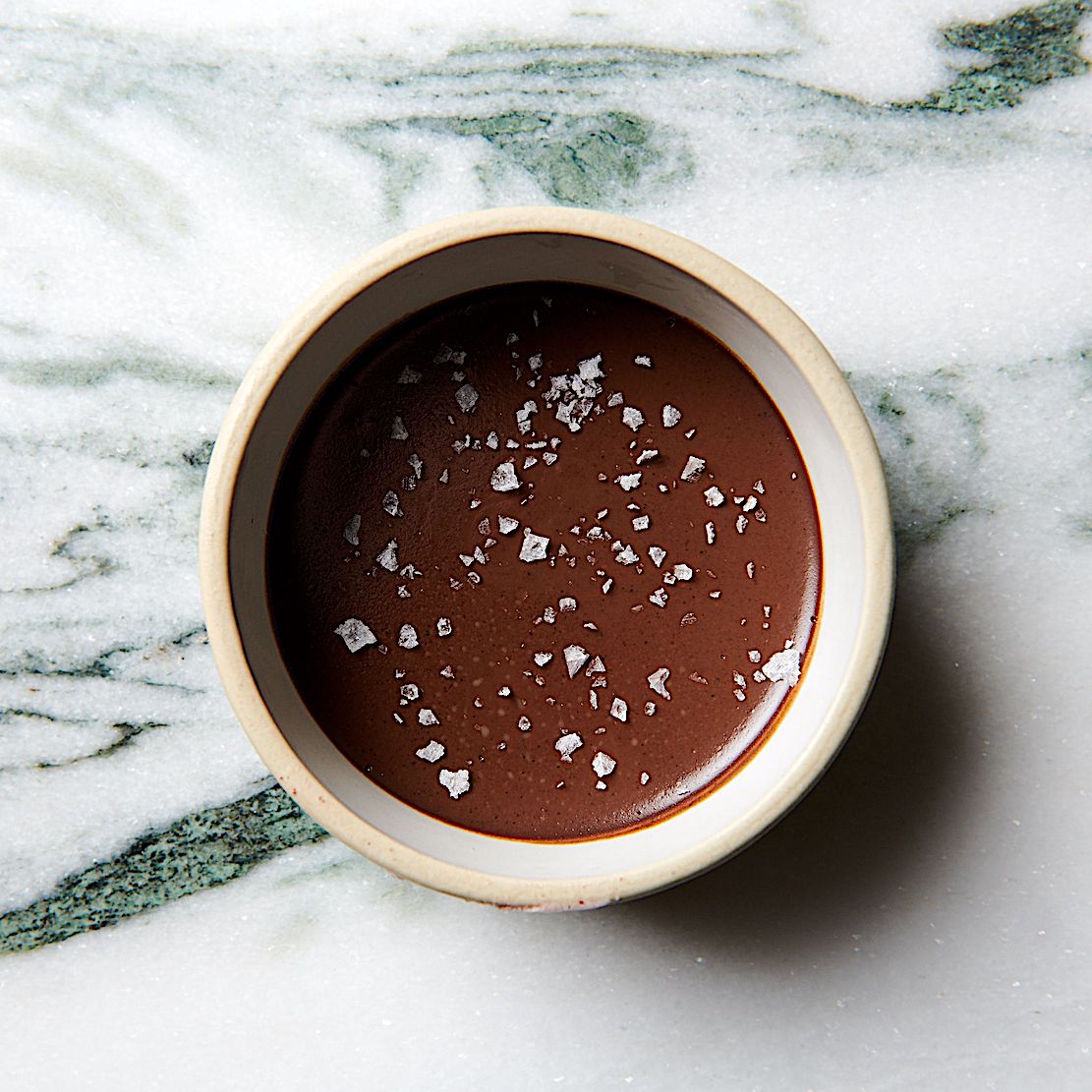 At MADRE the
desserts are fairly traditional,
including some deeply flavorful sorbets, but ever
since the idea of adding a
pinch of salt to caramel and chocolate exploded on
dessert menus everywhere
about ten years ago, that pinch has sometimes turned
into a spoonful. Thus,
MADRE’s chocolate pot de crème ($9) tasted more of
Maldon sea salt than
anything else (left). Much better was a Concord
grape soufflé with black sesame, black
lime and crème
anglaise ($15), and
an Eton Mess cake of Port-macerated huckleberries
and lime with crème fraîche
gelato ($9).
At MADRE the
desserts are fairly traditional,
including some deeply flavorful sorbets, but ever
since the idea of adding a
pinch of salt to caramel and chocolate exploded on
dessert menus everywhere
about ten years ago, that pinch has sometimes turned
into a spoonful. Thus,
MADRE’s chocolate pot de crème ($9) tasted more of
Maldon sea salt than
anything else (left). Much better was a Concord
grape soufflé with black sesame, black
lime and crème
anglaise ($15), and
an Eton Mess cake of Port-macerated huckleberries
and lime with crème fraîche
gelato ($9).
MADRE
has quickly established itself well ahead of the
pack of new places to dine in
Greenpoiint, which has a lot more hipster bars than
good restaurants, and I
think Noury's cooking will turn heads and alert
local competitors like Chez Ma
Tante and Sauvage to think a bit more creatively
than they currently do.
MADRE
is open for dinner Wed.-Sun.
❖❖❖
The Wines of Vincent Girardin
By John Mariani
Having
inherited five acres of vines from his
parents, whose family goes back to the 17th
Century in Burgundy, 19-year-old
Vincent Girardin, went out on his own in 1980 to
produce the best grapes he
could in the Côte de Beaune. His reputation grew
quickly as a pioneer in what
was called biodynamic viticulture in tradition-bound Burgundy.
tradition-bound Burgundy.
With winemaker Eric Germain, Girardin bucked
the trend in Burgundy for bigger-bodied,
high-alcohol wines in favor of
allowing nature itself to guide the vinification
process. Winemaking
additives were discontinued,
as were herbicides and insecticides, the
proportion of new barrels drastically
reduced. Natural composts from Burgundy farms were
used, high trellising was
adopted for better photosynthesis, and harvesting
was by hand, with grapes sorted
both in the vineyard and in the vat room.
In 2012 Girardin sold his winery to his partner
Jean-Pierre Nié, President of the Compagnie des
Vins d’Autrefois in Beaune, with
Germain continuing as winemaker and Marco Caschera
as director of world-wide
marketing.
I
had dinner in New York
with Caschera, 51, whose name is Italian, though
he was born in Lyon, France,
and he speaks with a light French accent. He
trained in finance but fell in
love with the wine industry, first joining the
marketing department of Maison
Nicholas. Since joining Maison Vincent Girardin he
has been constantly on the
move, trying to keep up with the flux that will be
caused by Brexit and the
100% tariff taxes threatened by Trump on European
wines. (As of this writing
the White House announced that Trump and French
President Macron "agreed it is
important to complete
successful negotiations on the digital services
tax," though did not
confirm his decision to hold off on tariffs for
now.)
 “Everyone
will be the loser,” said Caschera. “The Europeans
will lose market share and
sales of hundreds of millions of dollars. Some are
saying, ‘Ah, well, the
French will just sell their wine to other
countries,’ but, believe me, we
cannot find enough other countries to fill the
void left by the U.S., which
buys 20% of French wine exports [for more than $1
billion]. Japan’s purchases
are decreasing, places like Singapore are very
small markets. If this goes
through everyone is going to have to get very
creative in pricing.”
“Everyone
will be the loser,” said Caschera. “The Europeans
will lose market share and
sales of hundreds of millions of dollars. Some are
saying, ‘Ah, well, the
French will just sell their wine to other
countries,’ but, believe me, we
cannot find enough other countries to fill the
void left by the U.S., which
buys 20% of French wine exports [for more than $1
billion]. Japan’s purchases
are decreasing, places like Singapore are very
small markets. If this goes
through everyone is going to have to get very
creative in pricing.”
Caschera’s
other main concern is the change in environment,
while noting that for now “Burgundy
can always use more sunshine and heat.” But he has
already seen the effects of
global warming on his vineyards.
“We are
now harvesting two to three weeks earlier than we
were in 2003. We were
harvesting on August 20th this year, 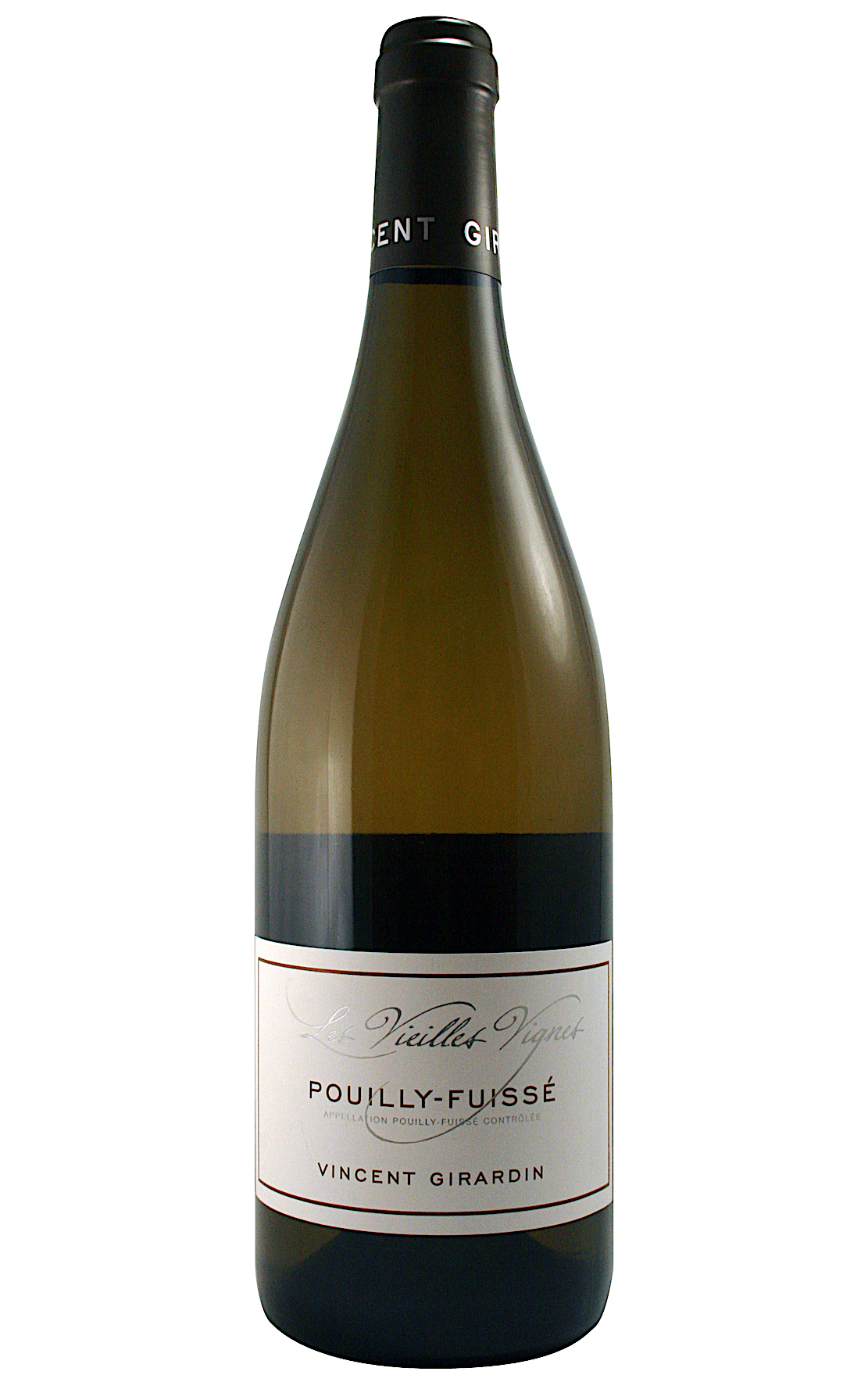 and some
regions like Monthélie,
Pernand-Vergelesses and Auxey-Duresses are always
ripe, every year now. Spring
starts before winter ends, so we see earlier bud
break.
and some
regions like Monthélie,
Pernand-Vergelesses and Auxey-Duresses are always
ripe, every year now. Spring
starts before winter ends, so we see earlier bud
break.
“We’re
also seeing more mildew like flavescence
dorée,
which has no cure and requires uprooting the
vines, especially in Maconnais.
And the use of chemicals is changing the character
of the terroir. It’s been
three years since I’ve seen a beetle in the
vineyards because of chemicals used in the
region, even though we
don't use chemicals in our vineyards. Bees are rare
too.”
Caschera
spoke of how even Vincent Girardin had, in the
1990s, adapted
the overripe, over-oaked style
called “the New School,” by which new viticultural
techniques were covering up
the character of the regional terroirs. With
Germain as winemaker of Maison
Girardin as of 2007, the winery shifted back to
older pre-1990s methods. “We
even tamp down the grapes with our feet for some
of our red wines,” said
Caschera, who noted that his reds are transparent,
not translucent nor murky,
indicating they had not been over-extracted.
Of
vintages from the last dozen years Caschera says
2007, 2014 and 2017 are the
best. Over dinner and back at home I was able to
taste through an array of
Maison Vincent Girardin wines, which are known for
their elegance rather than
their brawn.
 A good,
nicely priced introduction to Girardin’s wines is
their Chardonnay Cuvée
Saint-Vincent 2017 ($25), which has lovely fruit
and minerality. The Rully 2017
from “old vines” ($43) is from small village in
the Côte Chalonnaise that gives
the wine its name, made from 100% Chardonnay. It
is aged 12 months with wild
yeasts and placed in stainless steel to make the
blend. Rully is a wine to be
enjoyed fresh and not for aging.
A good,
nicely priced introduction to Girardin’s wines is
their Chardonnay Cuvée
Saint-Vincent 2017 ($25), which has lovely fruit
and minerality. The Rully 2017
from “old vines” ($43) is from small village in
the Côte Chalonnaise that gives
the wine its name, made from 100% Chardonnay. It
is aged 12 months with wild
yeasts and placed in stainless steel to make the
blend. Rully is a wine to be
enjoyed fresh and not for aging.
Unlike
so many mediocre Pouilly-Fuissés in the market,
Girardin’s 2016 ($43) shows that
age is in its favor, with complexity and flavors
of toasted nuts, which makes
it excellent with roast or fried chicken.
Meursault
Les Vielles Vignes 2017 ($82) is a luxurious white
wine based on three
principal vineyards south of the Côte de Beaune.
It spends 14 months in French
oak (only 15% new barrels) and now has layers of
floral flavors
with buttery
undertones but none of the sweetness that mars
lesser Burgundies or New World
Burgundies.
flavors
with buttery
undertones but none of the sweetness that mars
lesser Burgundies or New World
Burgundies.
Santenay
is a Pinot Noir from the Côte de Beaune based on
clay and a lot of limestone,
so you get a fine minerality. Girardin’s Santenay
Terre D’Enfance 2016 ($39) is
a moderately big style, very easy to like and very
adaptable to all kinds of
foods, including salmon and even salads with a
vinegar dressing.
Volnay
and Pommard are two of my favorite Burgundy wines
that don’t get the attention
they deserve. Girardin’s Volnay Les Vielles Vignes
2016 ($64) is a fine example
of a wine often described as “feminine” (in the
nicest way)
while the Pommard 2015 ($76) is more
“masculine.” The former is what good Burgundy
vines want to grow up to be, with
all the finesse and velvety virtues of the Pinot
Noir. Pommard, which is grown
between Beaune and Volnay (we are speaking of
small parcels and distances), is
a bigger bodied, more tannic wine and benefits
from a few years of aging in the
bottle. The estate’s tech notes explain the wine’s
biodynamic
tender-loving-care, saying, “Pommard is bottled
when the moon is down”
according to the lunar year’s “fruit day.”
Whatever.
But
if it works, who am I to judge. I’ll just drink
the wines with enormous
pleasure, happy that the “old” is new again at
Girardin and cautiously
optimistic that they can preserve their ancient
and revered terroir.
JUST WHAT
WE WERE LOOKING
FOR IN A THAI RESTAURANT!
"The Queens neighborhood of Elmhurst is where you go
when you want a Thai restaurant that will lead you
to the dance floor and push you into dips and twirls
that the places in Manhattan haven’t learned yet." —Pete Wells, "A Bangkok
Kitchen Hides Inside a Chinese Restaurant in
Queens," NY
Times (1/7/20).
 SAGE ADVICE
SAGE ADVICEAmong the "25
Mistakes Tourists Make While Visiting London" By Caroline Bologna: "1. Going
Inside The Red Phone Booths. Tourists visiting London often make
the mistake of thinking the classic red telephone
booths are great places to walk inside and take
photos in. However, many booths are used by late
night partygoers as urinals, so it’s best to capture
that epic photo from outside the booth.”
Any of John Mariani's books below may be ordered from amazon.com.
 The Hound in Heaven
(21st Century Lion Books) is a novella, and
for anyone who loves dogs, Christmas, romance,
inspiration, even the supernatural, I hope you'll find
this to be a treasured favorite. The story
concerns how, after a New England teacher, his wife and
their two daughters adopt a stray puppy found in their
barn in northern Maine, their lives seem full of promise.
But when tragedy strikes, their wonderful dog Lazarus and
the spirit of Christmas are the only things that may bring
his master back from the edge of despair.
The Hound in Heaven
(21st Century Lion Books) is a novella, and
for anyone who loves dogs, Christmas, romance,
inspiration, even the supernatural, I hope you'll find
this to be a treasured favorite. The story
concerns how, after a New England teacher, his wife and
their two daughters adopt a stray puppy found in their
barn in northern Maine, their lives seem full of promise.
But when tragedy strikes, their wonderful dog Lazarus and
the spirit of Christmas are the only things that may bring
his master back from the edge of despair. WATCH THE VIDEO!
“What a huge surprise turn this story took! I was completely stunned! I truly enjoyed this book and its message.” – Actress Ali MacGraw
“He had me at Page One. The amount of heart, human insight, soul searching, and deft literary strength that John Mariani pours into this airtight novella is vertigo-inducing. Perhaps ‘wow’ would be the best comment.” – James Dalessandro, author of Bohemian Heart and 1906.
“John Mariani’s Hound in Heaven starts with a well-painted portrayal of an American family, along with the requisite dog. A surprise event flips the action of the novel and captures us for a voyage leading to a hopeful and heart-warming message. A page turning, one sitting read, it’s the perfect antidote for the winter and promotion of holiday celebration.” – Ann Pearlman, author of The Christmas Cookie Club and A Gift for my Sister.
“John Mariani’s concise, achingly beautiful novella pulls a literary rabbit out of a hat – a mash-up of the cosmic and the intimate, the tragic and the heart-warming – a Christmas tale for all ages, and all faiths. Read it to your children, read it to yourself… but read it. Early and often. Highly recommended.” – Jay Bonansinga, New York Times bestselling author of Pinkerton’s War, The Sinking of The Eastland, and The Walking Dead: The Road To Woodbury.
“Amazing things happen when you open your heart to an animal. The Hound in Heaven delivers a powerful story of healing that is forged in the spiritual relationship between a man and his best friend. The book brings a message of hope that can enrich our images of family, love, and loss.” – Dr. Barbara Royal, author of The Royal Treatment.
 |
The Encyclopedia of American Food and Drink by John F. Mariani (Bloomsbury USA, $35) Modesty forbids me to praise my own new book, but let me proudly say that it is an extensive revision of the 4th edition that appeared more than a decade ago, before locavores, molecular cuisine, modernist cuisine, the Food Network and so much more, now included. Word origins have been completely updated, as have per capita consumption and production stats. Most important, for the first time since publication in the 1980s, the book includes more than 100 biographies of Americans who have changed the way we cook, eat and drink -- from Fannie Farmer and Julia Child to Robert Mondavi and Thomas Keller. "This book is amazing! It has entries for everything from `abalone' to `zwieback,' plus more than 500 recipes for classic American dishes and drinks."--Devra First, The Boston Globe. "Much needed in any kitchen library."--Bon Appetit. |
"Eating Italian will never be the same after reading John Mariani's entertaining and savory gastronomical history of the cuisine of Italy and how it won over appetites worldwide. . . . This book is such a tasteful narrative that it will literally make you hungry for Italian food and arouse your appetite for gastronomical history."--Don Oldenburg, USA Today. "Italian
restaurants--some good, some glitzy--far
outnumber their French rivals. Many of
these establishments are zestfully described
in How Italian Food Conquered the World, an
entertaining and fact-filled chronicle by
food-and-wine correspondent John F.
Mariani."--Aram Bakshian Jr., Wall Street
Journal.
"Equal parts
history, sociology, gastronomy, and just
plain fun, How Italian Food Conquered the
World tells the captivating and delicious
story of the (let's face it) everybody's
favorite cuisine with clarity, verve and
more than one surprise."--Colman Andrews,
editorial director of The Daily
Meal.com. "A fantastic and fascinating
read, covering everything from the influence
of Venice's spice trade to the impact of
Italian immigrants in America and the
evolution of alta cucina. This book will
serve as a terrific resource to anyone
interested in the real story of Italian
food."--Mary Ann Esposito, host of PBS-TV's
Ciao
Italia. "John Mariani has written the
definitive history of how Italians won their
way into our hearts, minds, and
stomachs. It's a story of pleasure over
pomp and taste over technique."--Danny Meyer,
owner of NYC restaurants Union Square
Cafe, The Modern, and Maialino.
|
 |
 |
 |
 |
 |
 |
 |
 |
 Everett Potter's Travel Report:
Everett Potter's Travel Report: 
 Eating Las Vegas
JOHN CURTAS has been covering the Las Vegas
food and restaurant scene since 1995. He is
the co-author of EATING LAS VEGAS – The 50
Essential Restaurants (as well as
the author of the Eating Las Vegas web site: www.eatinglasvegas.
He can also be seen every Friday morning as
the “resident foodie” for Wake Up With the
Wagners on KSNV TV (NBC) Channel 3 in
Las Vegas.
Eating Las Vegas
JOHN CURTAS has been covering the Las Vegas
food and restaurant scene since 1995. He is
the co-author of EATING LAS VEGAS – The 50
Essential Restaurants (as well as
the author of the Eating Las Vegas web site: www.eatinglasvegas.
He can also be seen every Friday morning as
the “resident foodie” for Wake Up With the
Wagners on KSNV TV (NBC) Channel 3 in
Las Vegas.
MARIANI'S VIRTUAL GOURMET
NEWSLETTER is published weekly. Publisher: John Mariani. Editor: Walter Bagley. Contributing Writers: Christopher Mariani,
Robert Mariani, Misha Mariani, John A. Curtas, Gerry Dawes, Geoff Kalish,
and Brian Freedman. Contributing
Photographer: Galina Dargery. Technical
Advisor: Gerry
McLoughlin.
If you wish to subscribe to this
newsletter, please click here: http://www.johnmariani.com/subscribe/index.html
© copyright John Mariani 2020

